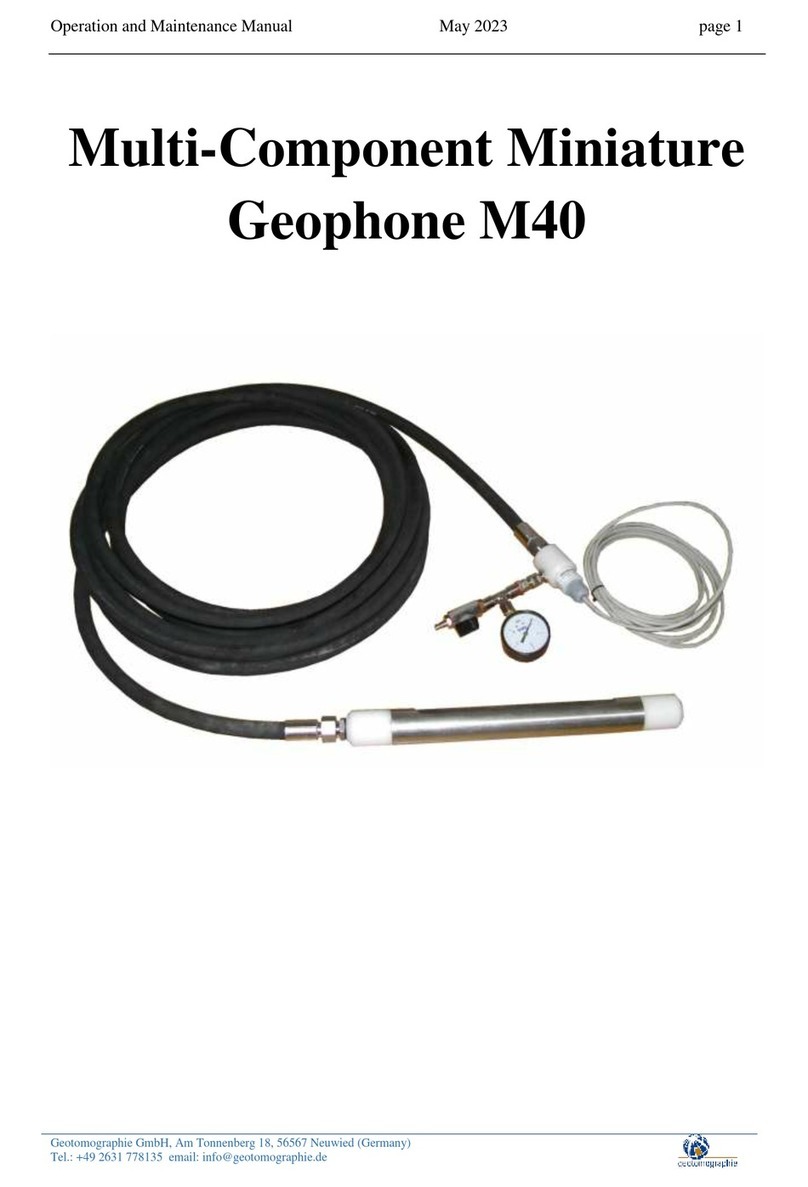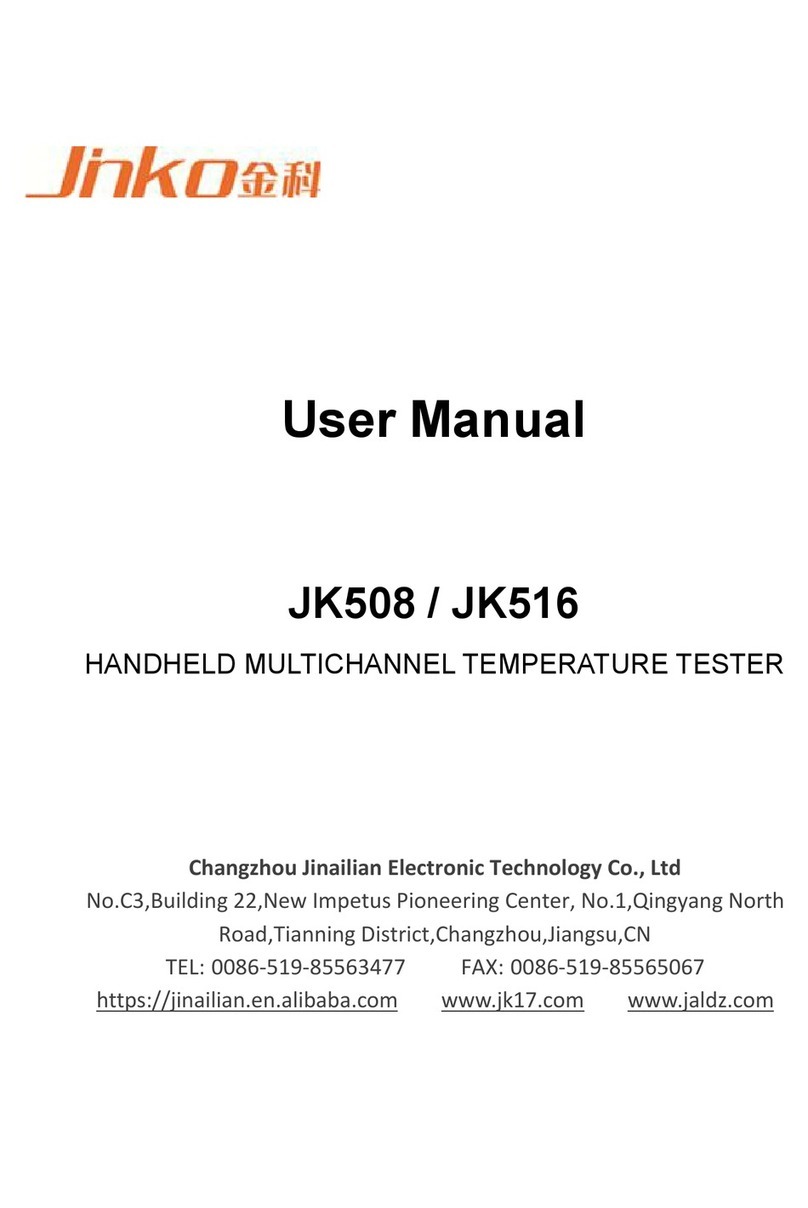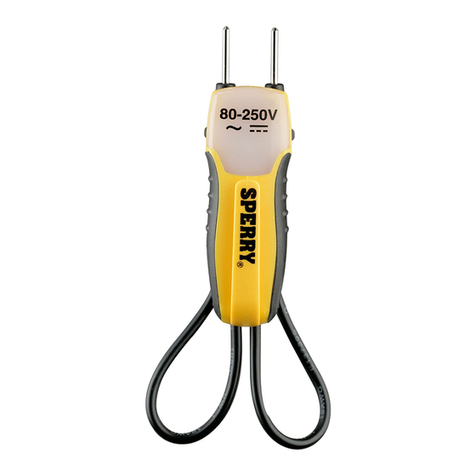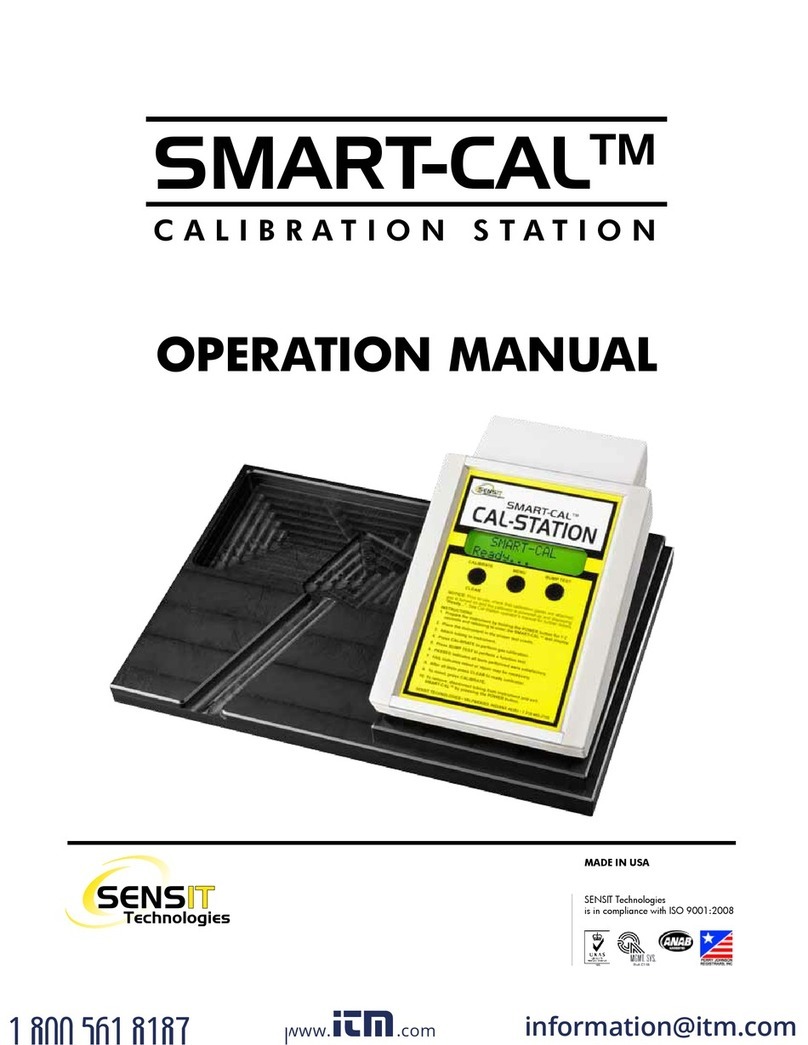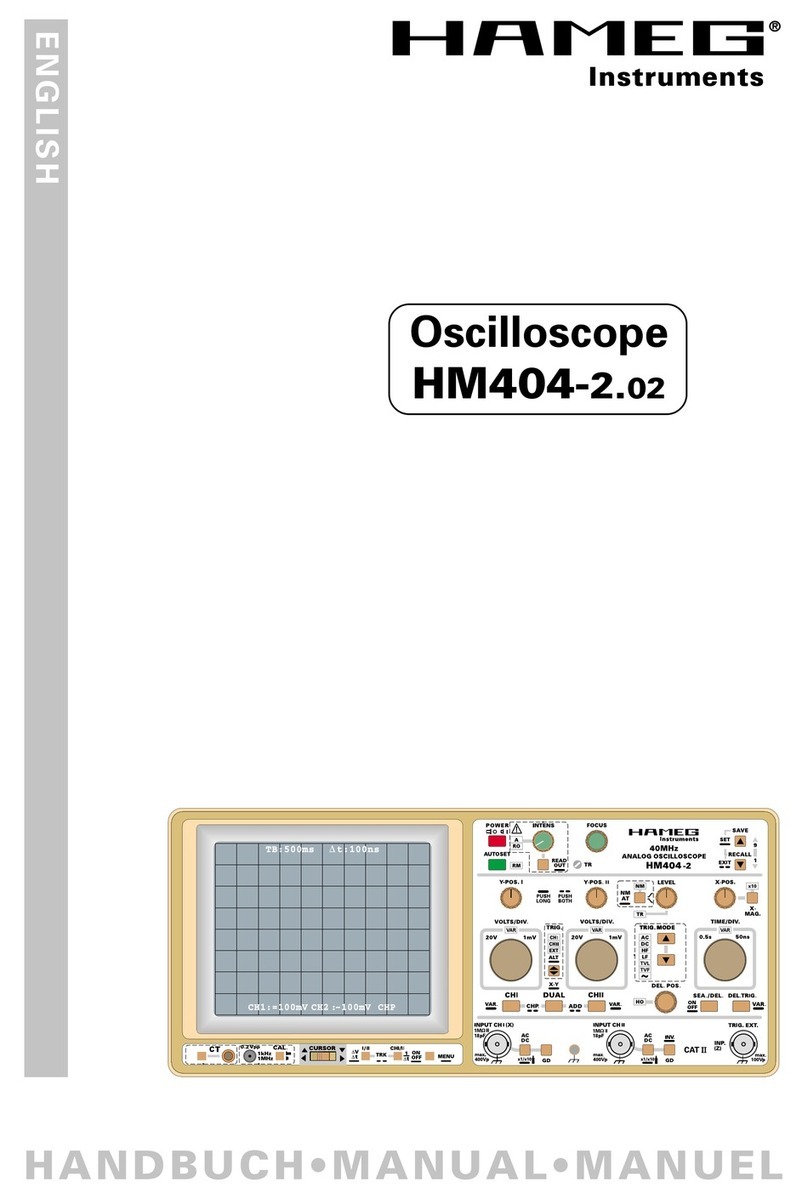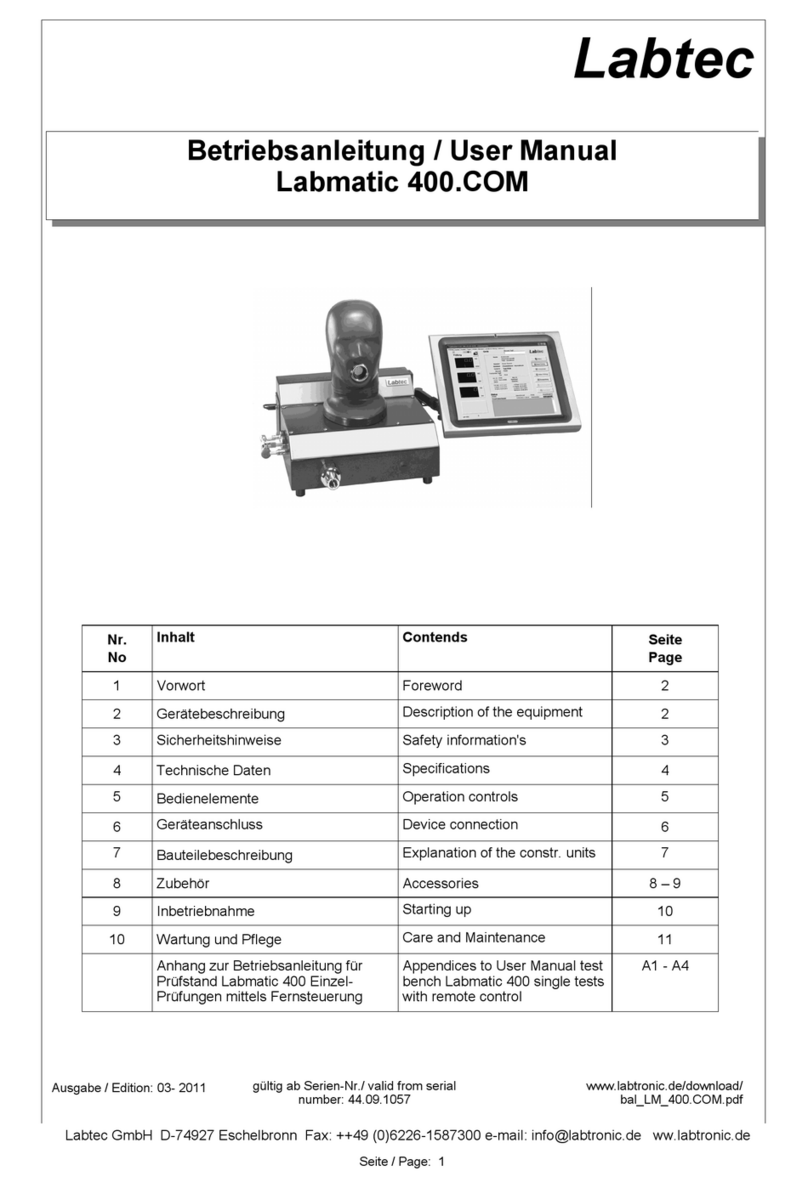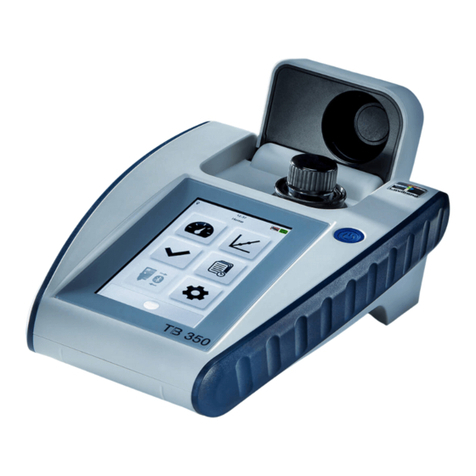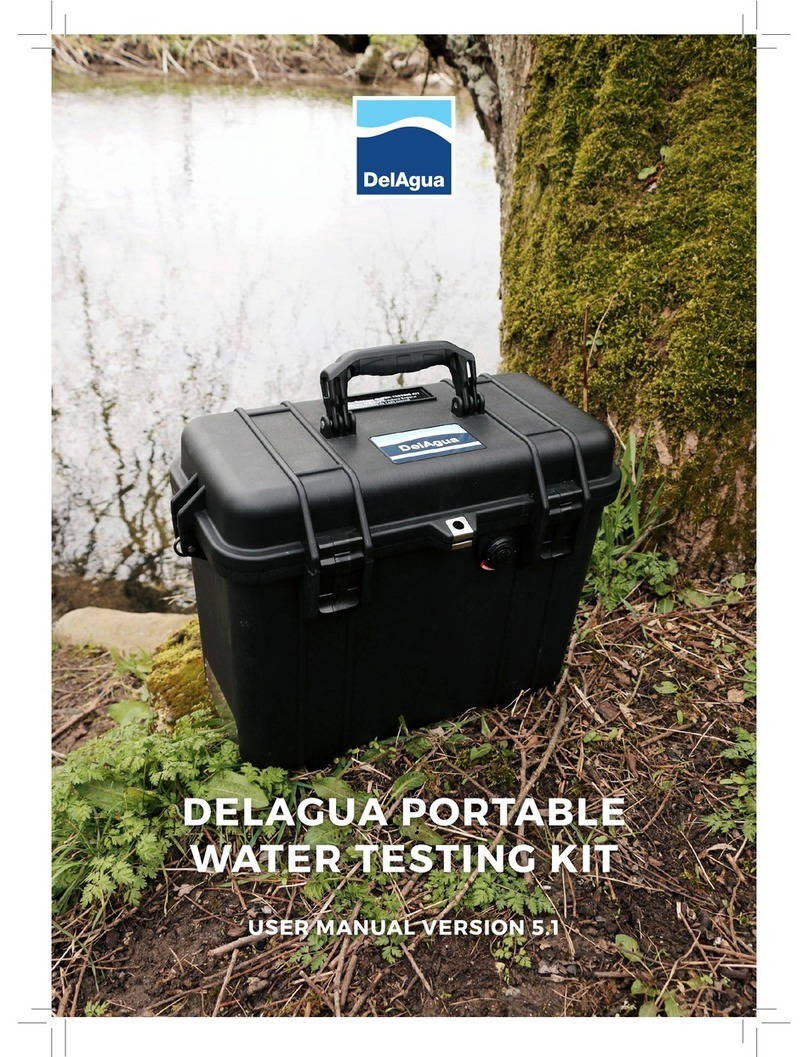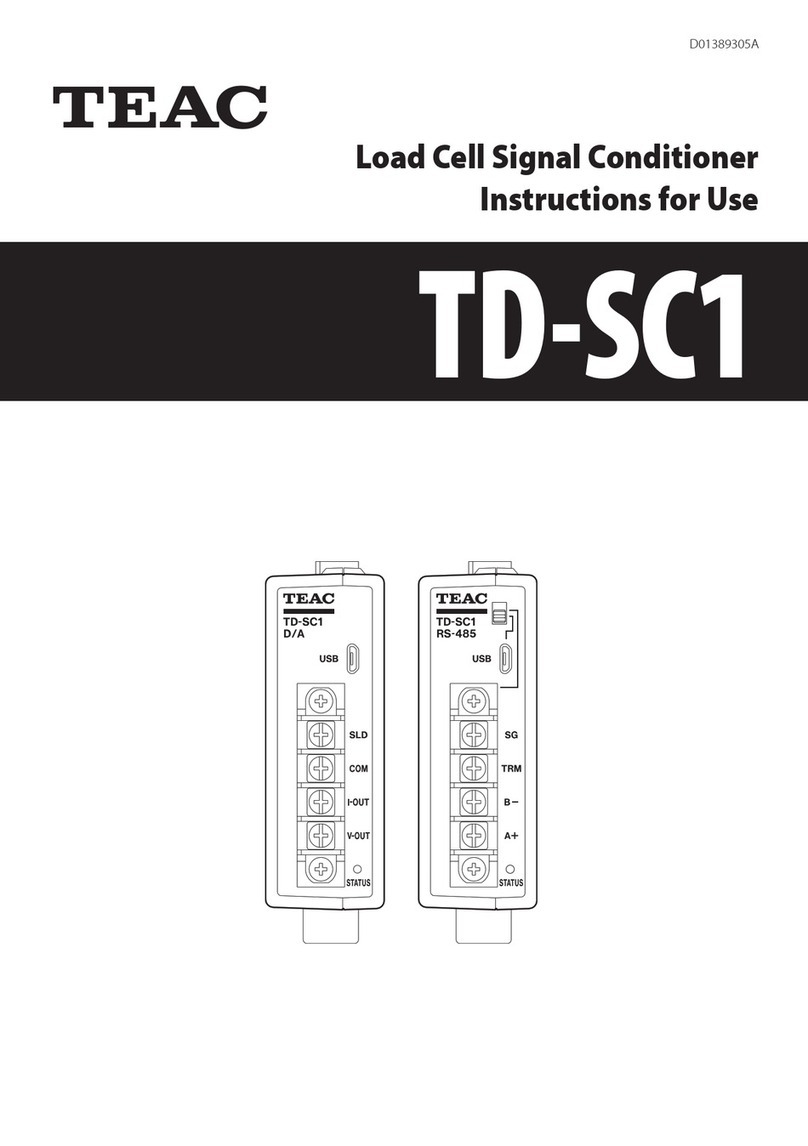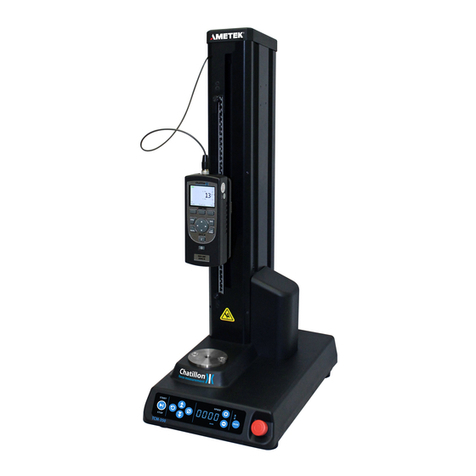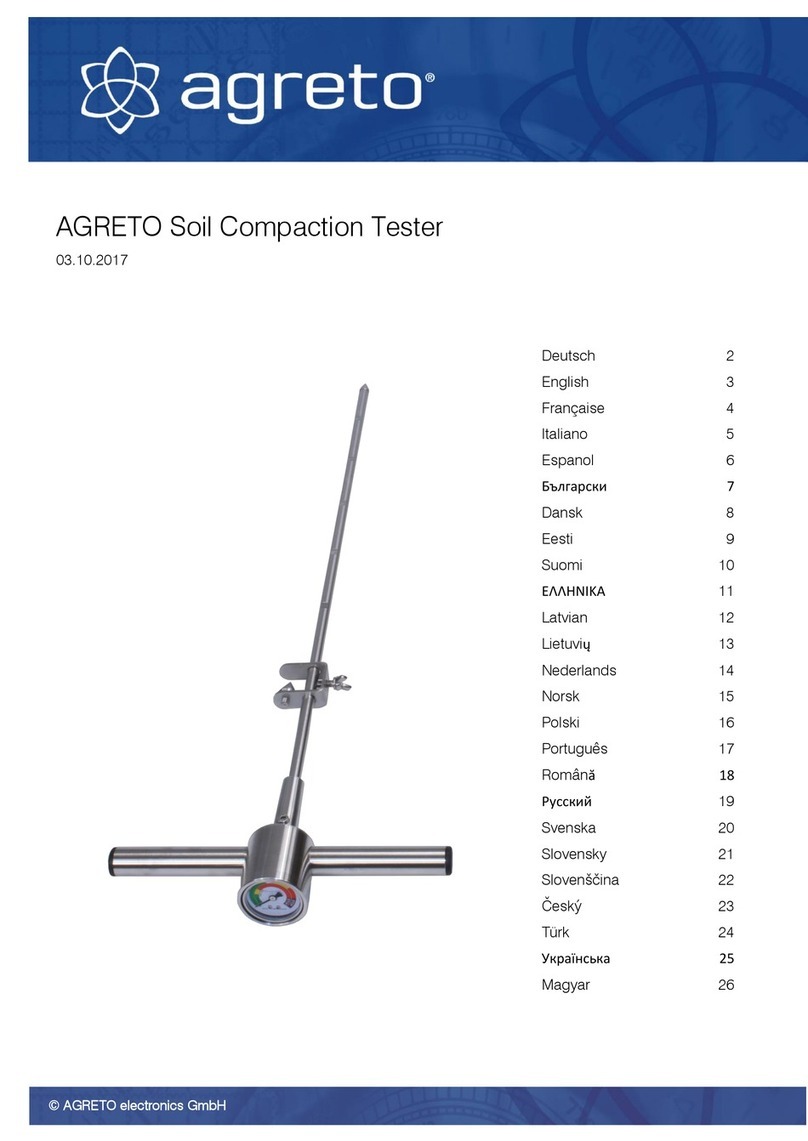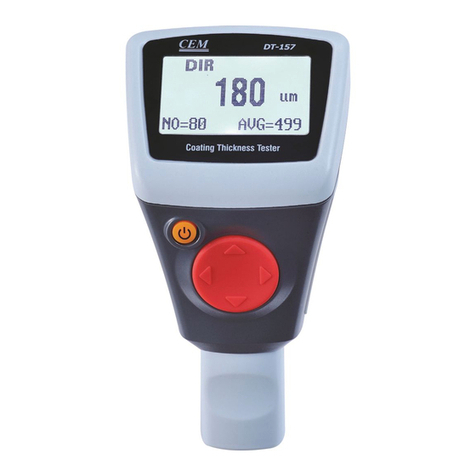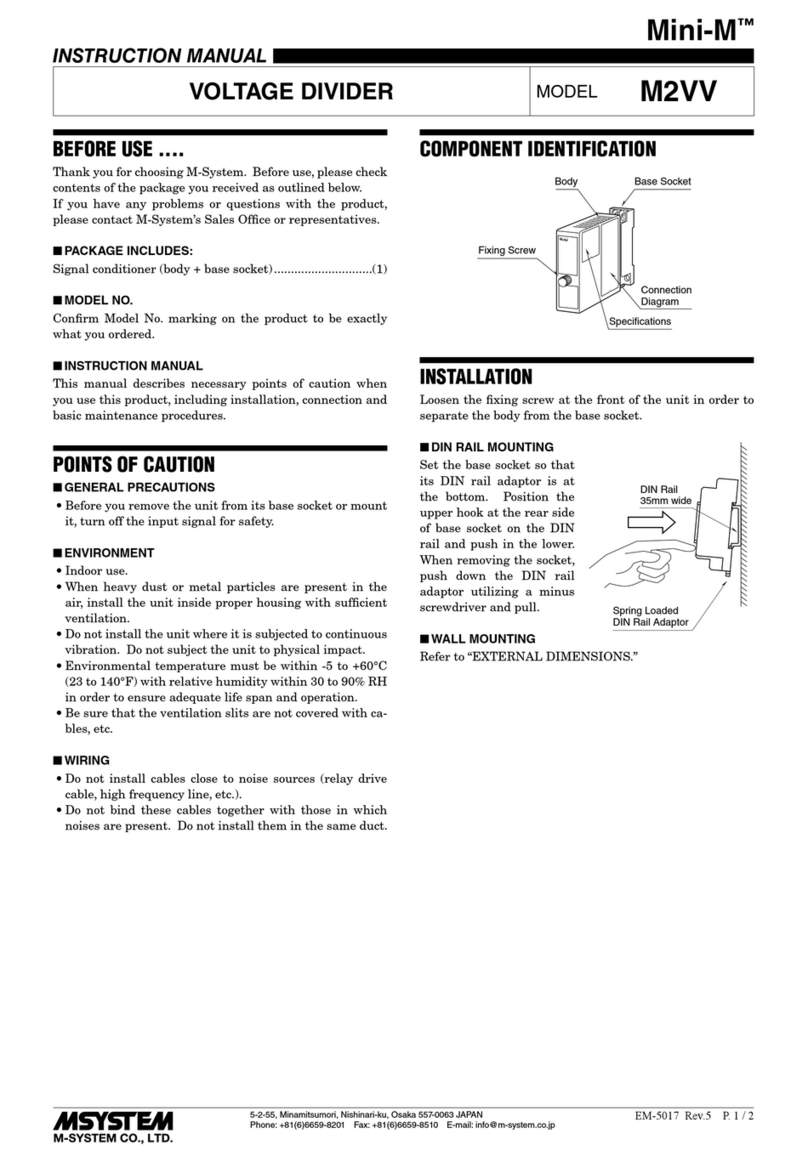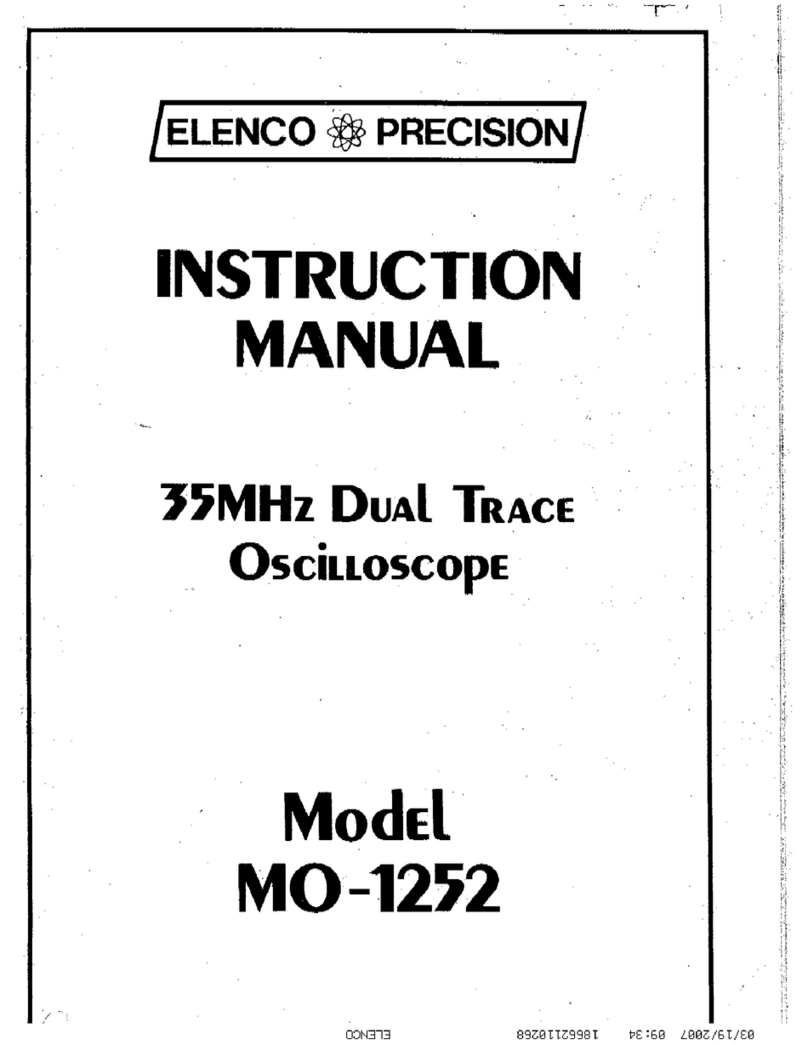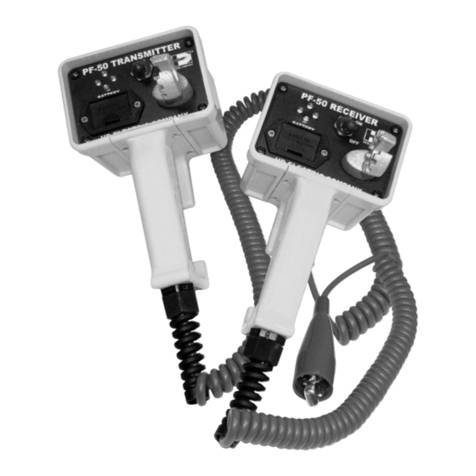geotomographie SBS42 User manual

Borehole Sources SBS-42/BIS-SH
and
Impulse Generator IPG5000
Operating and Maintenance Manual
1. Impulse generator 4
1.1 Connections at IPG5000 and set-up 5
2. Remote control unit 9
2.1 Function and operating of remote control 10
2.1.1 Generator control 10
2.1.2 Impulse control 10
2.1.3 Trigger 11
3. Downhole equipment 11
3.1 P-Wave probe SBS42 12
3.2 S-Wave probe BIS-SH 13
4. Operation and Maintenance Instructions 17
4.1 Impulse generator and remote control unit 17
4.1.1 Preliminary works 17
4.1.2 . Impulse operation control (EXTERN) - controlled by remote unit 18
4.1.3 Impulse operation control INTERN 19
4.1.4 Setting OFF operation 19
4.2 SBS42probe 20
4.3 BIS-SH probe 20
4.3.1 Clamping pressure for BIS-SH probe 21
4.3.2 Orienting the BIS-SH probe 21
4.4 Surface cable and quick connector 23
5. Trouble shooting 24
5.1 Check triggering 24
5.2 SBS42 test arrangement 25
5.3 Tomography arrangement 26
5.4 Crosshole arrangement 26
5.5. General checks 27

Precautions
for
Operation of high voltage equipment type SBS42 and BIS-SH
Like other seismic sources as explosives, air guns or weight dropping systems,
operating of an electrical spark or other high-voltage impulse sources requires several
precautions. The most important precautions are:
1. Impulse generator operation only by authorised personnel.
2. Do not connect or disconnect cables whilst impulse generator
is switched ON. Switch OFF impulse generator before
disconnecting cables or connectors.
3. Do not touch cables or sparker probe while the impulse
generator is in operation.
4. Ground the impulse generator by means of grounding hook
before switching ON.
5. Do not expose impulse generator or connectors to water or
dust.
6. Do not charge impulse generator over 5.300 V !
7. Do not open impulse generator or remote control.
Maintenance has to be carried out by authorised personnel.
8. In case of any malfunction or emergency switch OFF impulse
generator by pressing the red OFF button at generator or turn
key switch OFF at remote control.

Moreover observe the following:
•Check cables and connectors before and after every field survey for damage.
•Do not use damaged cables.
•Do not open the impulse generator if connected to power source.
•Any repairs or maintenance work has to be carried out only by authorised
personnel.
•All connections should be dry to avoid a flash over inside the connector.
Take care that no water e.g. rain can get into connectors.
•If an impulse is released without a spark action the cable can be charged with high
voltage like a small condenser. This energy has to be discharged by switching OFF
the impulse generator. Check this by observing the HV-meter. Wait until the
voltmeter at impulse generator shows a voltage of nearly 0 volt!
•High voltage discharges slowly (about 1 - 2 minutes). Wait until the voltmeter at
impulse generator shows a voltage of nearly 0 volt!
1. Impulse generator
The impulse generator IPG5000 is the high voltage power supply to the seismic
sparker probe SBS42 or BIS-SH. Figure 1 shows the impulse generator and its remote
control RCU.
Fig. 1: Impulse generator IPG and remote control unit RCU.

The IPG5000 needs to be powered by external 230 V / 50 Hz or optional 115 V / 60
Hz. If voltage drops below 210 V the system is not operating. Output energy of the
IPG5000 is 1000 J @ 5000 V.
Impulses can be released in single or continuous mode either by using the remote
control unit RCU or by using the controls at the IPG5000 control panel. The HV-output
has no direct contact to the generator housing, i.e. the terminals +HV and -HV are
connected to housing and ground via two resistors of 15 Meach.
To prevent electromagnetic interference the generator should be operated in a
certain distance to the seismograph. Avoid crossing cables.
Attention:
The impulse generator must be protected from any wetness, e.g. rain and dust!
Before switching “ON”the ground terminal of generator must be connected to
ground using the grounding hook via the yellow-green cable. If the ground is
very dry add water to the grounding hook to enable a good soil contact.
1.1 Connections at IPG5000 and set-up
Following accessories for operation of the impulse generator are delivered:
1. Grounding hook with cable (colour yellow/green)
2. Power supply cable (grey) with connector (type suitable to national standards)
3. Remote control unit with cable (black)
4. High-voltage surface cable (big red cable) for connection between impulse
generator and borehole cable having a length of approx. 6 m equipped with a
coaxial quick connector (sleeve part) for connection to surface connector of the
borehole coaxial cable.
Please follow the instruction below to connect cables to IPG5000.
Connect the cables to the IPG5000 is in same order (from 1 to 4).
Do not connect power cable to external power supply. This shall be done at last
after setting up all other connections.
Disconnect the cables from the IPG5000 is in same order (from 4 to 1) but
switch off unit first and disconnect VAC.
NEVER disconnect while under operation or while the unit is charged.
Next, the borehole probe SBS42 or BIS-SH can be connected to the IPG5000 through
the big red HV cable (see chapter 5.3/5.4).

Fig. 2: Cable connections at IPG5000
Fig. 3: Details of connecting points at IPG5000 rear side
Fig. 4: Rubber fixation of HV connector at IPG5000

1
23
4567 8 9
Fig. 5: Control panel at IPG5000
At the front panel of the IPG5000 several control and push buttons are available (see
Fig. 5).
1. Voltmeter
2. Key switch (0=OFF, 1=ON)
3. Fuses (from left to right with 0.8 A, 4 A, 4 A)
4. EMERGENCY OFF
5. Voltage (230V) switch ON
6. High-Voltage switch ON
7. Single release button (only available for internal operation)
8. Shot sequence timer (fully left for single shots, fully right for 10 s shot release,
all other positions intermediate shot timing)
9. INTERN/EXTERN switch (to left = INTERN, to right = EXTERN for remote unit
controlled operation)
On emergency situations switch OFF the IPG5000 using the key switch (2) or press
red push button (4).

ON OFF M0,8/250C
(0,8Amedium slow) (4Aslow) (4Aslow)
T4/250E T4/250E
OFF ON HV-ON SINGLE-
IMPULSE 4-7sec
IMPULSE GENERATOR
EXTERNINTERN
CONTI
FUSES
Fusefor Control 2xFusesfor H PartV
Fig. 6: Schematic diagram of the control panel at IPG5000
If all connections to IPG5000 are made, the remote control unit is connected AND
the source is connected and inside borehole one can start the high voltage
charging.
The switching ON sequence at the IPG5000 control panel is as follows:
1. Key switch to “1” (same at remote control unit)
2. Switch shot control at remote control unit to SINGLE
3. If external VAC is available the white push button lights
4. Press white push-button (5)
5. Green push button lights
6. Press green push-button (6)
7. High voltage charging starts
8. Avoid charging above 5300 V. Switch OFF if charging is above and adjust VAC
supply
Connection to downhole probe is established through the “quick” connector at the big
red HV cable. Just push in the probes coaxial cable connector and screw tightly.
Fig. 7: Connection between coaxial cable and big red HV cable at IPG5000

2. Remote control unit
The remote control unit fulfils following functions:
1. Switch ON the IPG5000
2. Emergency OFF for interrupting any operation
3. Shot release in SINGLE or CONTINUOUS mode
4. Impulse counting of released shots
5. Trigger signal output to seismograph
The remote control unit is connected to the IPG5000 by one cable. All electronic
circuits of the remote control unit (except the trigger circuit) are supplied by 24 V
delivered by the impulse generator via the cable.
The trigger circuit is supplied by a battery of 9 V.
Fig. 8: Controls at remote control unit

Fig. 9: Rear side of RCU with banana trigger and connector to IPG5000
2.1 Function and operation of the remote control unit
To use remote control mode, the switch at the IPG5000 has to be set to position
EXTERN. Remote Control is sub-divided into three panels.
2.1.1 Generator control (left panel at remote unit)
The key switch at the remote control unit must be set to “1” to start operation at the
IPG5000. Further, the EMERGENCY button must be in UP position.
In emergency case press “EMERGENCY OFF” button or switch to “0” the key
switch.
2.1.2 Impulse control (middle panel at remote unit)
The remote control unit is equipped with a counter for counting impulses. Shots can
be released in continuous or single mode.
To release a single shot switch to “Single” and press the red button shortly.
The red LED (on right panel of the control unit) lights shortly on triggering.
For starting continuous impulse operation switch to “Continuous”. You may select
faster or longer impulse rates by turning the turning knob. After a delay of several
seconds the first impulse (shot) will be released if “Continuous” was selected. The
impulse rate can be selected by the controller between about 4 and about 9 seconds.
Continuous shot operation is stopped by switching to “SINGLE”.

2.1.3 Trigger (right panel at remote unit)
For trigger operation switch ON toggle switch. A red LED indicates the trigger circuit
is ON.
The signal level of the impulse reference signal, transmitted from impulse generator,
can be adjusted by means of the trimmer Trigger LEVEL. Turn to right to make trigger
more sensitive and turn left to make trigger insensitive. Anyhow, the level is already
adjusted. New adjustment should only be carried out be well experienced users.
Since June 2016 there is a BNC connector available where the trigger level can be
measured using a voltmeter. Trigger level of 50mV has to be set by adjusting the
trigger trimmer.
To test correct triggering of the seismograph one can push the “Test” button.
Trigger impulse polarity can be selected positive raise or negative raise by means of
the switch. Polarity setting has effect on trigger output. If a seismic recorder needs a
short circuit for triggering down going slope has to be chosen (from high to low).
Trigger polarity (TTL Active Low = right switch position, TTL Active High = left switch
position)
3. Downhole equipment
The IPG5000 outputs its energy to the borehole sources SBS42 or BIS-SH.
The borehole source SBS42 generates compressional waves (P) in water filled
boreholes. Energy released by the IPG5000 discharges through a coaxial cable
terminated by two adjacent spark electrodes placed in a water filled chamber. The
spark discharge vaporizes the water by high pressure plasma. This generates vapour
bubbles which expand and collapse, thereby generating high-frequency seismic
waves.
The borehole source BIS-SH generates horizontally polarized shear waves (SH) and
compressional waves (P). The source works in dry or water filled boreholes and can be
used in vertical or horizontal boreholes. Energy released by the IPG5000 discharges
through a system of electromagnetic coils adjacent to a copper plate. When the plate
is rejected a mechanical impact to the borehole wall is generated. The borehole
source is coupled to the borehole wall by a pneumatic clamping system (inflatable
bladder). The orientation of the source is controlled from surface by a torsional stiff
hose.

3.1 P-Wave probe SBS42 (sparker)
The downhole sparker probe SBS42 consists of the probe head, an exchangeable spark
electrode and the housing (see Fig. 10).
Probe Head
Spark Electrode
Housing
Bottom Screw
Fig. 10: SBS42 downhole probe
The probe head connects the probe electrically with the coaxial HV cable. The
exchangeable electrode is a high duty long life spark electrode made of stainless steel
and a tungsten-copper alloy inner electrode. The housing is made of a plastic tube
with a rubber protection around. Openings made in the plastic tube allow an
omnidirectional pressure release into the rock formation. The lower end is sealed by a
bottom screw.
The housing can be filled with water through the bottom screw thread. Just remove
the screw and fill with water. You may add some salt to the water to increase
electrical conductivity (1/2 table spoon to 500 ml water). Close bottom screw. In case
the water conductivity is low enough that a spark is generated you may also just
remove the bottom screw and lower the probe below the water table. After a few
seconds the housing gets filled with water.
A small amount of gas produced by the effect of electrolysis of the current impulses
pass slim channels and can escape the probe through openings in the probe head.
The spark electrode is constructed for long-time operation and has a total working life
of several thousands of shots. It is recommended to flatten the front electrode
surface after about 1000 to 2000 shots using a mechanical file tool.
In case of a replacement of the electrode make sure system is switched OFF. Hold
electrode downwards while replacing to avoid water migrating into the probe head.
Put grease only on O-rings.
Grease spark electrode O-rings only. Do not grease the spark electrode thread.
If the sparker probe is filled with water do not shot in free air. Due to lack of
sufficient static counter pressure the rubber hose can be overloaded by to large

extension. For this reason the minimum operation depth should be no less than about
one meter below water table.
The rubber tube section can be dismantled for repair or maintenance works, e.g. of
the spark electrode.
3.2 S-Wave probe BIS-SH
The BIS probe consists of the probe head, two half sleeves, the rubber protected and
sealed active probe part, an air packer and the lower probe part (see Fig. 11).
Fig. 11: BIS-SH downhole probe
The probe head is connected to the rotary pipe string. Always check this connection if
tight. The rotary pipe string has three functions, i.e. to (1) protect the inner coaxial
cable, to be used for orienting the source (2) and to guide air to the packer (3).
The two half sleeves connect the probe head to the active probe part. To maintain
cable connection (cleaning) and to connect/disconnect air hose one may open one
side for operation (see Fig 12.).
The active part of the source contains a seismic source working after the eddy current
principle. A high duty rubber tube (3 mm wall thickness) protects the HV part from
water and dust.

Fig. 12: Half-Sleeves with HV cable and pressure hose connector
The probe active probe part (shooting direction) needs to be aligned to the rotary
string marking (see Fig. 13).
Fig. 13: Rotary string alignment (points towards shooting direction)
Fig. 14: Rotary string depth markers

The air clamping part can easily be removed by unscrewing from the active part.
Fig. 15: Unscrew to replace air bladder
The BIS-SH probe can work in water filled and dry boreholes.
Anyhow, while working in dry holes inner temperature of the coil system raises fast up
(to 100°C). Make sure that no overheating occurs (for example: after a 30...50 shots
in continuous mode without stopping). On normal operation (5 stacks per direction)
no overheating should occur.
Check rubber tube at active probe part regularly. If rubber is damaged water might
migrate into the coil system. This causes a short in the coil system and leads to a
total damage of the inner coil system.
Fig. 16: BIS-SH surface splitter arrangement
The borehole rotary string ends in a white plastic cylinder typically directly mounted
on the drum (see Fig. 16). This end terminator splits off the HV cable and the air
connection (to inflate the BIS-SH packer).

The description of Fig 16 is as follows:
1: Splitter
2: Push-Pull connection at valve-gauge adapter
3: Pressure gauge
4: Valve
5: Connector to air pump
A special adapter with gauge and valve can be connected to the air-in connector. It’s
a push-pull connection at the gauge-valve adapter. An air pump is provided to inflate
the packer for clamping the source to the borehole wall. Also here it’s a push-pull
connection.
Once air pressure is applied to inflate the packer close the valve and disconnect the
air pump. Without disconnecting air cannot being released. Keep the push-pull
connectors always clean!

4. Operation and maintenance instructions
4.1 Impulse generator and remote control unit (surface equipment)
4.1.1 Preliminary works
Plant earth hook to ground. In case of dry soil pour some water around the spike
to improve conductivity. Connect earth hook with green/yellow cable to impulse
generators ground (rear side).
Accomplish all cable connections for surface and subsurface equipment
according to the instructions
Connect AC power cable (but do not switch on the AC generator till the end of
all preparation operations)
Put downhole probe into borehole and fix with clamping device.

4.1.2 Impulse operation control (EXTERN) - controlled by remote unit
•Key switch at remote control unit to “1” and emergency button is UP
•Set toggle switch at remote control unit to SINGLE
•Switch trigger on at remote control unit and set trigger type (low, high)
•Connect the impulse generator to mains or other AC-current source
•White lamp lights and indicates readiness for switching on the IPG5000
•Switch to EXTERN ( ) at IPG5000
•Set key switch at IPG5000 to “1”
•Press white push-button (green lamp lights).
•Press green push-button at IPG5000
(Now, the high voltage circuit is switched-on internally and charging of the
condenser bank is started (see voltage meter). The Impulse generator is ready
for impulse operation by remote unit controlling.
•System is ready to work
•If SINGLE shot release is set at remote unit press red button at middle remote
unit panel to release single shots.
•If CONTINUOUS shot release is set at remote unit shots are automatically
released. You may set repetition rate at turning knob.
•Stop continuous shooting by switching to SINGLE.

4.1.3 Impulse operation control INTERN
When using the generator without operation from remote control, following steps
have to be carried out:
- Follow steps described under 4.1.1
-Connect blind plug to IPG800 instead of remote control cable
-Trigger signal can be obtained from BNC connector located at rear side of
IPG5000 (available since June 2016)
- Shot sequence timer at impulse generator for select shot cycle rate fully left!
- Switch toggle switch at impulse generator to INTERN ( )
- Switch key switch at IPG5000 to “1”
- Press white push-button ON at IPG5000
- Press green push-button HV-ON (impulse generator charges now)
- You may release single shot by pressing the blue push-button shortly !!!
Note: As long as you press the blue button impulse generator discharges via downhole
cable! Danger, do not touch any parts of the downhole probe or electrically
connected parts to it.
-Alternatively, you may release continuous shots by selecting an impulse rate at
shot sequence timer
-For shut down press red button OFF or use key switch.
4.1.4 Setting OFF operation
•Turn key switch at remote control unit to position “0”.
•Alternatively and equivalent
press red button at impulse generator
press emergency button at remote control unit
switch key at IPG5000 to position “0”

4.2 SBS42 probe (sparker)
Before starting any maintenance work make sure the probe is disconnected from
IPG5000.
In case of a damaged housing rubber tube, the electrode sparker function is not
disturbed under normal conductivity conditions of the borehole fluid (water).
Anyhow, the rubber hose can be easily exchanged.
Do not use probe without housing.
It is recommended to flatten the front electrode surface after about 1000 to 2000
shots using a mechanical file tool.
Check coaxial cable for damages, i.e. breaks and cuts. Do not pull cable over sharp
edges. Do not drive over cable or step on it.
To repair such cable damages for short time wind some self-vulcanic tape or
insulating tape around the damaged spots to avoid a penetration of water.
For checking cable isolation use a multi-meter.
4.3BIS-SH probe
Before starting any maintenance work make sure the probe is disconnected from
IPG5000.
Check rubber tube for damages.
Do not work with damaged rubber tube.
Avoid extensive shooting in dry boreholes as the probe might heat up quickly.
This manual suits for next models
2
Table of contents
Other geotomographie Test Equipment manuals

